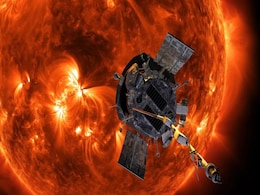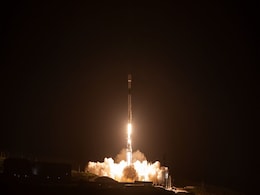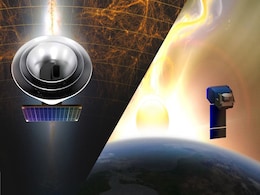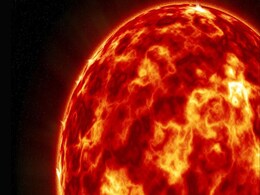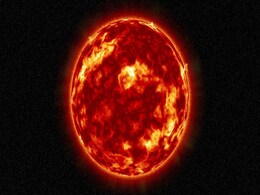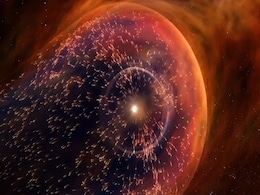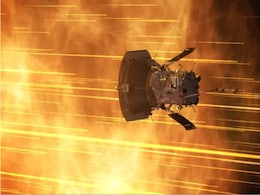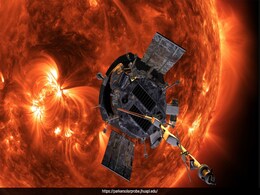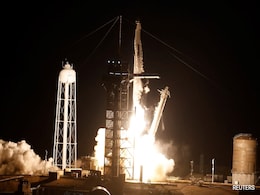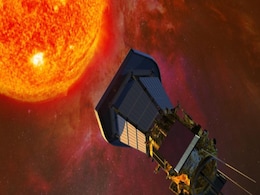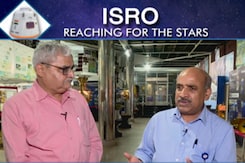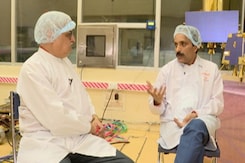Sun Mission
- All
- News
- Videos
- Web Stories
-

NASA’s Parker Solar Probe Completes Second Close Flyby of the Sun at Record Speed
- Monday April 7, 2025
- Written by Gadgets 360 Staff
NASA’s Parker Solar Probe completed a close flyby of the Sun on March 22, travelling at 692,000 kilometres per hour and approaching within 6.1 million kilometres of the solar surface. The mission, designed to study solar winds and space weather, received a healthy signal back on March 25. The team, including NASA and Johns Hopkins APL experts, ha...
-
 www.gadgets360.com
www.gadgets360.com
-

SpaceX Falcon 9 Successfully Deploys NASA’s SPHEREx Telescope and PUNCH Probes
- Thursday March 13, 2025
- Written by Gadgets 360 Staff
NASA’s SPHEREx and PUNCH missions have successfully launched aboard a SpaceX Falcon 9 rocket from Vandenberg Space Force Base in California. SPHEREx will map the entire celestial sky in 102 infrared colours, while PUNCH will study the transition of the sun’s corona into the solar wind. The two-year missions aim to deepen our understanding of th...
-
 www.gadgets360.com
www.gadgets360.com
-

Aditya-L1’s SUIT Telescope Captures First-Ever Solar Flare Kernel, Revealing Unseen Solar Activity
- Friday March 7, 2025
- Written by Gadgets 360 Staff
India’s Aditya-L1 mission has achieved a historic milestone with its Solar Ultra-violet Imaging Telescope (SUIT) capturing the first-ever solar flare kernel in the near-ultraviolet spectrum. This unprecedented observation confirms energy transfer across different layers of the Sun's atmosphere, advancing the understanding of solar flares and spac...
-
 www.gadgets360.com
www.gadgets360.com
-

NASA’s New Missions Will Map the Sun and the Cosmos
- Tuesday March 4, 2025
- Written by Gadgets 360 Staff
NASA is set to launch two major missions, PUNCH and SPHEREx, aboard a SpaceX Falcon 9 from Vandenberg Space Force Base on March 2. PUNCH, a four-satellite system, will study the sun’s corona and space weather, while SPHEREx will create infrared maps of the cosmos to study galaxy evolution and cosmic history. These missions will contribute to a de...
-
 www.gadgets360.com
www.gadgets360.com
-

NASA’s PUNCH Mission Set to Track the Sun’s Corona and Solar Wind in 3D
- Friday February 7, 2025
- Written by Gadgets 360 Staff
NASA’s PUNCH mission, set for launch on Feb 27, will deploy four satellites to study the transition between the sun’s corona and the solar wind. The mission aims to improve understanding of space weather by capturing 3D images, helping predict solar storms with greater accuracy. The data will also complement NASA’s Parker Solar Probe, offerin...
-
 www.gadgets360.com
www.gadgets360.com
-

Study Finds Coronal Loop Flickers Could Predict Solar Flares Hours in Advance
- Friday January 17, 2025
- Written by Gadgets 360 Staff
NASA's Solar Dynamics Observatory has revealed a potential breakthrough in predicting solar flares. Scientists observed brightness fluctuations in coronal loops—plasma structures in the Sun's atmosphere—that intensify hours before solar flares occur. This discovery, with a prediction accuracy of 60–80%, may provide 2–6 hours of advance warn...
-
 www.gadgets360.com
www.gadgets360.com
-

ESA Uses Solar Orbiter to Turn Solar Flares into Sound, Offering New Insights
- Thursday January 16, 2025
- Written by Gadgets 360 Staff
The European Space Agency (ESA), in collaboration with NASA, has used data from the Solar Orbiter mission to convert solar flares into audible sound. By mapping solar flare data into blue circles and pairing them with tones, a new way to experience solar activity has been created. This process is linked to the sun’s 11-year solar cycle, with curr...
-
 www.gadgets360.com
www.gadgets360.com
-

Solar Missions in 2025: Heliophysics Projects and Spacecrafts That Will Study the Sun
- Saturday January 4, 2025
- Written by Gadgets 360 Staff
The study of the sun, its activity, and effects across the solar system will advance in 2025. With Solar Cycle 25 peaking, six NASA missions planned, and new research priorities outlined, scientists are poised to address long-standing questions about solar dynamics and their impacts. Missions such as IMAP, ESCAPADE, and PUNCH will investigate solar...
-
 www.gadgets360.com
www.gadgets360.com
-

NASA Confirms Successful Flyby of Parker Solar Probe, Completes Closest Sun Approach
- Monday December 30, 2024
- Written by Gadgets 360 Staff
NASA's Parker Solar Probe has set an unprecedented milestone, coming 3.8 million miles from the Sun at a speed of 430,000 mph. Launched in 2018, the spacecraft has utilised Venus flybys to perfect its orbit, enabling this historic feat. With advanced technology, it endures extreme temperatures, gathering critical data about solar wind and particle ...
-
 www.gadgets360.com
www.gadgets360.com
-

Organic Molecules in Space: A Key to Understanding Life's Cosmic Origins
- Saturday December 28, 2024
- Written by Gadgets 360 Staff
Organic molecules, the building blocks of life, have been discovered across space—from interstellar clouds to asteroids and comets. Findings from missions like Rosetta, Hayabusa2, and Osiris-Rex reveal that these compounds existed long before the Sun formed. Scientists believe organic molecules survived planetary formation in protoplanetary disks...
-
 www.gadgets360.com
www.gadgets360.com
-

Parker Solar Probe's Closest Sun Flyby Sets Records, Signal Expected Soon
- Friday December 27, 2024
- Written by Gadgets 360 Staff
The Parker Solar Probe achieved the closest-ever sun flyby on Christmas Eve, reaching within 3.8 million miles of the solar surface and travelling at 430,000 miles per hour. Scientists are now waiting for a signal expected on December 27 to confirm the spacecraft’s health. Detailed telemetry and collected data are anticipated by January 1, with o...
-
 www.gadgets360.com
www.gadgets360.com
-

NASA's Parker Solar Probe Makes Closest Ever Pass By The Sun
- Tuesday December 24, 2024
- World News | Agence France-Presse
NASA's pioneering Parker Solar Probe made history Tuesday, flying closer to the Sun than any other spacecraft with its heat shield exposed to scorching temperatures of more than 1,700 degrees Fahrenheit (930 degrees Celsius).
-
 www.ndtv.com
www.ndtv.com
-

What Time Is NASA's Parker Solar Probe Closest Sun Flyby on Christmas Eve?
- Friday December 27, 2024
- Written by Gadgets 360 Staff
On Dec. 24 at 6:53 a.m. EST, NASA’s Parker Solar Probe will achieve its closest flyby of the Sun at 3.8 million miles. The mission, part of a seven-year study, aims to uncover the mysteries of the Sun’s corona and solar wind. Travelling at 430,000 mph, the spacecraft is protected by a heat shield designed to withstand extreme temperatures. Upda...
-
 www.gadgets360.com
www.gadgets360.com
-

NASA’s Parker Solar Probe Achieves Closest Sun Flyby Ever on December 24
- Monday December 23, 2024
- Written by Gadgets 360 Staff
NASA’s Parker Solar Probe will make its closest-ever flyby of the sun on December 24, 2024, passing within 3.8 million miles of the solar surface at a speed of 430,000 mph. This marks the 22nd close encounter of the spacecraft’s mission, which aims to provide unprecedented insights into the sun’s corona and other solar phenomena. Despite extr...
-
 www.gadgets360.com
www.gadgets360.com
-

Parker Solar Probe to Break Records with Historic Sun Flyby on December 24
- Friday December 13, 2024
- Written by Gadgets 360 Staff
NASA's Parker Solar Probe is set for a record-breaking approach to the sun on December 24, travelling at 430,000 mph and reaching within 3.8 million miles of the surface. The spacecraft, equipped with advanced heat shields, will navigate solar plasma plumes and potentially an active eruption during this phase of heightened solar activity. This flyb...
-
 www.gadgets360.com
www.gadgets360.com
-

NASA’s Parker Solar Probe Completes Second Close Flyby of the Sun at Record Speed
- Monday April 7, 2025
- Written by Gadgets 360 Staff
NASA’s Parker Solar Probe completed a close flyby of the Sun on March 22, travelling at 692,000 kilometres per hour and approaching within 6.1 million kilometres of the solar surface. The mission, designed to study solar winds and space weather, received a healthy signal back on March 25. The team, including NASA and Johns Hopkins APL experts, ha...
-
 www.gadgets360.com
www.gadgets360.com
-

SpaceX Falcon 9 Successfully Deploys NASA’s SPHEREx Telescope and PUNCH Probes
- Thursday March 13, 2025
- Written by Gadgets 360 Staff
NASA’s SPHEREx and PUNCH missions have successfully launched aboard a SpaceX Falcon 9 rocket from Vandenberg Space Force Base in California. SPHEREx will map the entire celestial sky in 102 infrared colours, while PUNCH will study the transition of the sun’s corona into the solar wind. The two-year missions aim to deepen our understanding of th...
-
 www.gadgets360.com
www.gadgets360.com
-

Aditya-L1’s SUIT Telescope Captures First-Ever Solar Flare Kernel, Revealing Unseen Solar Activity
- Friday March 7, 2025
- Written by Gadgets 360 Staff
India’s Aditya-L1 mission has achieved a historic milestone with its Solar Ultra-violet Imaging Telescope (SUIT) capturing the first-ever solar flare kernel in the near-ultraviolet spectrum. This unprecedented observation confirms energy transfer across different layers of the Sun's atmosphere, advancing the understanding of solar flares and spac...
-
 www.gadgets360.com
www.gadgets360.com
-

NASA’s New Missions Will Map the Sun and the Cosmos
- Tuesday March 4, 2025
- Written by Gadgets 360 Staff
NASA is set to launch two major missions, PUNCH and SPHEREx, aboard a SpaceX Falcon 9 from Vandenberg Space Force Base on March 2. PUNCH, a four-satellite system, will study the sun’s corona and space weather, while SPHEREx will create infrared maps of the cosmos to study galaxy evolution and cosmic history. These missions will contribute to a de...
-
 www.gadgets360.com
www.gadgets360.com
-

NASA’s PUNCH Mission Set to Track the Sun’s Corona and Solar Wind in 3D
- Friday February 7, 2025
- Written by Gadgets 360 Staff
NASA’s PUNCH mission, set for launch on Feb 27, will deploy four satellites to study the transition between the sun’s corona and the solar wind. The mission aims to improve understanding of space weather by capturing 3D images, helping predict solar storms with greater accuracy. The data will also complement NASA’s Parker Solar Probe, offerin...
-
 www.gadgets360.com
www.gadgets360.com
-

Study Finds Coronal Loop Flickers Could Predict Solar Flares Hours in Advance
- Friday January 17, 2025
- Written by Gadgets 360 Staff
NASA's Solar Dynamics Observatory has revealed a potential breakthrough in predicting solar flares. Scientists observed brightness fluctuations in coronal loops—plasma structures in the Sun's atmosphere—that intensify hours before solar flares occur. This discovery, with a prediction accuracy of 60–80%, may provide 2–6 hours of advance warn...
-
 www.gadgets360.com
www.gadgets360.com
-

ESA Uses Solar Orbiter to Turn Solar Flares into Sound, Offering New Insights
- Thursday January 16, 2025
- Written by Gadgets 360 Staff
The European Space Agency (ESA), in collaboration with NASA, has used data from the Solar Orbiter mission to convert solar flares into audible sound. By mapping solar flare data into blue circles and pairing them with tones, a new way to experience solar activity has been created. This process is linked to the sun’s 11-year solar cycle, with curr...
-
 www.gadgets360.com
www.gadgets360.com
-

Solar Missions in 2025: Heliophysics Projects and Spacecrafts That Will Study the Sun
- Saturday January 4, 2025
- Written by Gadgets 360 Staff
The study of the sun, its activity, and effects across the solar system will advance in 2025. With Solar Cycle 25 peaking, six NASA missions planned, and new research priorities outlined, scientists are poised to address long-standing questions about solar dynamics and their impacts. Missions such as IMAP, ESCAPADE, and PUNCH will investigate solar...
-
 www.gadgets360.com
www.gadgets360.com
-

NASA Confirms Successful Flyby of Parker Solar Probe, Completes Closest Sun Approach
- Monday December 30, 2024
- Written by Gadgets 360 Staff
NASA's Parker Solar Probe has set an unprecedented milestone, coming 3.8 million miles from the Sun at a speed of 430,000 mph. Launched in 2018, the spacecraft has utilised Venus flybys to perfect its orbit, enabling this historic feat. With advanced technology, it endures extreme temperatures, gathering critical data about solar wind and particle ...
-
 www.gadgets360.com
www.gadgets360.com
-

Organic Molecules in Space: A Key to Understanding Life's Cosmic Origins
- Saturday December 28, 2024
- Written by Gadgets 360 Staff
Organic molecules, the building blocks of life, have been discovered across space—from interstellar clouds to asteroids and comets. Findings from missions like Rosetta, Hayabusa2, and Osiris-Rex reveal that these compounds existed long before the Sun formed. Scientists believe organic molecules survived planetary formation in protoplanetary disks...
-
 www.gadgets360.com
www.gadgets360.com
-

Parker Solar Probe's Closest Sun Flyby Sets Records, Signal Expected Soon
- Friday December 27, 2024
- Written by Gadgets 360 Staff
The Parker Solar Probe achieved the closest-ever sun flyby on Christmas Eve, reaching within 3.8 million miles of the solar surface and travelling at 430,000 miles per hour. Scientists are now waiting for a signal expected on December 27 to confirm the spacecraft’s health. Detailed telemetry and collected data are anticipated by January 1, with o...
-
 www.gadgets360.com
www.gadgets360.com
-

NASA's Parker Solar Probe Makes Closest Ever Pass By The Sun
- Tuesday December 24, 2024
- World News | Agence France-Presse
NASA's pioneering Parker Solar Probe made history Tuesday, flying closer to the Sun than any other spacecraft with its heat shield exposed to scorching temperatures of more than 1,700 degrees Fahrenheit (930 degrees Celsius).
-
 www.ndtv.com
www.ndtv.com
-

What Time Is NASA's Parker Solar Probe Closest Sun Flyby on Christmas Eve?
- Friday December 27, 2024
- Written by Gadgets 360 Staff
On Dec. 24 at 6:53 a.m. EST, NASA’s Parker Solar Probe will achieve its closest flyby of the Sun at 3.8 million miles. The mission, part of a seven-year study, aims to uncover the mysteries of the Sun’s corona and solar wind. Travelling at 430,000 mph, the spacecraft is protected by a heat shield designed to withstand extreme temperatures. Upda...
-
 www.gadgets360.com
www.gadgets360.com
-

NASA’s Parker Solar Probe Achieves Closest Sun Flyby Ever on December 24
- Monday December 23, 2024
- Written by Gadgets 360 Staff
NASA’s Parker Solar Probe will make its closest-ever flyby of the sun on December 24, 2024, passing within 3.8 million miles of the solar surface at a speed of 430,000 mph. This marks the 22nd close encounter of the spacecraft’s mission, which aims to provide unprecedented insights into the sun’s corona and other solar phenomena. Despite extr...
-
 www.gadgets360.com
www.gadgets360.com
-

Parker Solar Probe to Break Records with Historic Sun Flyby on December 24
- Friday December 13, 2024
- Written by Gadgets 360 Staff
NASA's Parker Solar Probe is set for a record-breaking approach to the sun on December 24, travelling at 430,000 mph and reaching within 3.8 million miles of the surface. The spacecraft, equipped with advanced heat shields, will navigate solar plasma plumes and potentially an active eruption during this phase of heightened solar activity. This flyb...
-
 www.gadgets360.com
www.gadgets360.com

